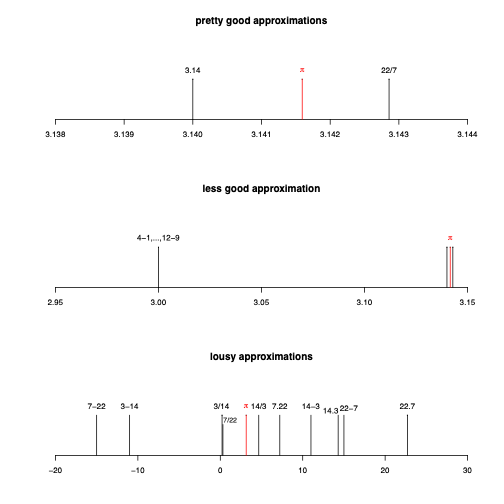By Brian J. Gaines
Few readers of this blog will need convincing that the number conventionally represented by the Greek letter π is truly marvelous. It can be defined as the ratio of any circle’s circumference to its diameter, but it pops up all over, not only in the geometry of circles. What is the sum of the inverses of all squared positive integers? Remarkably,
Surprisingly, the following is a proper equation, and not an approximation:
March 14 has been celebrated as “pi day” at least since 1988, when the San Francisco Exploratorium hosted an event in honor of this transcendental number. (A transcendental number cannot be expressed as the root of a polynomial with rational coefficients. The set of them is uncountably infinite, but proving that a given number is transcendental can be very hard.) The inspiration is obvious: 3.14 are the first three digits of π.
July 22 is an alternative “pi day” because 22/7 is also a reasonably good approximation of π, a bit better than 3.14, in fact. It is sometimes referred to as “pi approximation day,” a designation that should annoy anyone who holds π in affection, given that both 3.14 and 22/7 are, of course, mere approximations. Some call March 14 “American pi day” and July 22 “international pi day,” because listing dates in the order month, day, year (MDY) is common in the United States, while the more logical DMY format---which respects size of unit in its ordering---is routine in much of the rest of the world.
However, an obvious, but neglected point immediately follows. The separators employed with either MD or DM date formats (ignoring the year placement) determine whether or not the date actually resembles either of those π approximations. Except when discussing pi day, Americans almost never employ periods to separate the day, month, and year components of a date. The slash (southwest to northeast) is the most popular separator in the US, with a dash or minus sign trailing behind as a second option. Of course, neither 3/14 nor 3-14(=-11) is at all a good approximation of π. Where, outside of a gathering of math fans, might one see March 14 actually written as “3.14”? Where is July 22 rendered as “22/7”? The answers, it turns out, appear to be, nowhere, and here and there.

What is the most common date format for each country in the world? A Wikipedia page summarizing preferred local customs notes that the most official standard, ISO 8601, is YYYY-MM-DD. If one ignores the year, the resemblance of the horizontal line separator to the minus sign ensures that there is no better approximation for π in this format than 3, from 4-1 (April 1), May 2, June 3, July 4, August 5, September 6, October 7, November 8, and December 9. None of those dates can claim priority as the best pi day and, frankly, 3 is not a good enough approximation of π to make a compelling case for having nine pi days each year.
Where, in the world, is the MDY ordering common? Not many places, outside of the United States. More popular is YMD, that ISO ordering that moves from largest to smallest units, proceeding from left to right. However, nearly all of the YMD countries use dashes, not periods, as separators. In fact, if you scour the details on that Wikipedia page, you find no instances of the MD format and period (or dot or point) separator being listed as commonly employed. Sorry, March 14, but it seems you are not really “pi day” anywhere.
The situation is less bleak for July 22. There are about 40 instances of the D/M format being identified as in use, albeit very often as a less popular alternative to D.M or D-M. In many countries, “22/7” would not be too unusual in a date field. The only territories where that format is uniquely identified as the local norm are Cyprus, Iraq, Italy, Niue, Palestine, Saudi Arabia, Somalia, and Thailand.
Wikipedia is never wrong, right? I started checking passport applications for each of these polities online, to see if I could confirm the date formats. The Cyprus application does employ slashes, but with no instructions about where to write days, months, or years. Instructions on passport issuance in Iraq are headed “04 May.” The English version of the Italian Chicago consulate’s news page permits searching by dates, but with M/D/Y format, not D/M. Most of the dates at the English-language version of the Government of Niue's website are written with months rendered as words, not numbers. Reassuringly, however, legislation dates employ D/M/Y. Maybe it is better not to check up on the Wikipedia results too carefully.
So, this July 22, if your budget permits, head to Niue for a slice of papaya-coconut cream pie, and think fond thoughts about π. Do the same at home next March 14, if you like, but know that it isn't really “pi day,” no matter where you are, alas.

Brian J. Gaines is the Honorable W. Russell Arrington Professor in State Politics, University of Illinois system.
